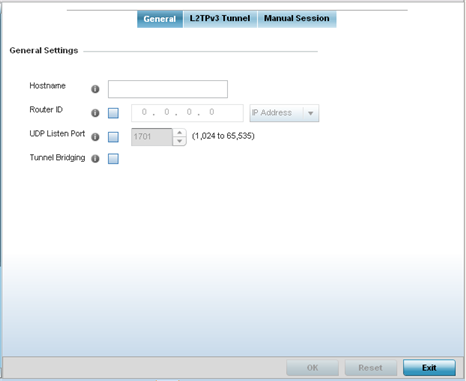General
To define an L2TPV3 configuration for a profile:
-
Select .
-
Expand the Network menu and select L2TPv3.
The General tab displays by default.
-
Set the following General Settings for a L2TPv3 profile configuration:
Host Name Define a 64 character maximum host name to specify the name of the host that's sent tunnel messages. Tunnel establishment involves exchanging 3 message types (SCCRQ, SCCRP and SCCN) with the peer. Tunnel IDs and capabilities are exchanged during the tunnel establishment with the host.
Router ID Set either the numeric IP address or the integer used as an identifier for tunnel AVP messages. AVP messages assist in the identification of a tunneled peer.
UDP Listen Port Select this option to set the virtual port used for listening to incoming traffic. Select a port from 1,024 - 65,353.
Device Type Select this option to enable or disable bridge packets between two tunnel end points. This setting is disabled by default.
- In the Logging
Settings filed, configure the following settings:
Enable Logging Select this option to enable the logging of Ethernet frame events to and from bridge VLANs and physical ports on a defined IP address, host or router ID. This setting is disabled by default. IP Address Optionally use a peer tunnel ID address to capture and log L2TPv3 events. Hostname If not using an IP address for event logging, optionally use a peer tunnel hostname to capture and log L2TPv3 events. Router ID If not using an IP address or a hostname for event logging, use a router ID to capture and log L2TPv3 events. -
Select OK to save the changes. Select Reset to revert to the last saved configuration.

